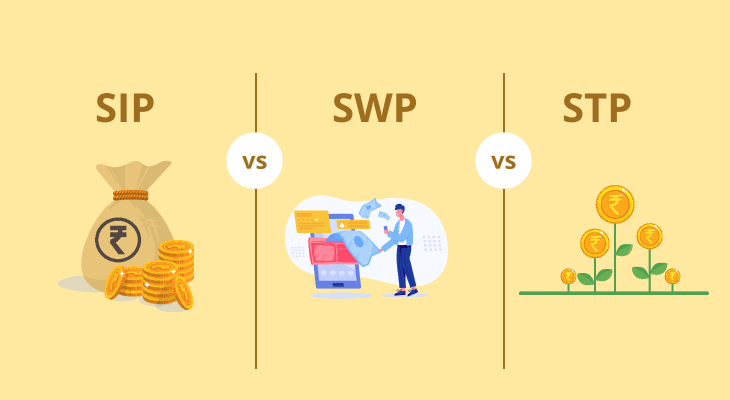
Direct vs Regular Mutual Funds
In the intricate landscape of mutual funds, investors often have to choose between direct plan vs regular plan, each bearing distinct characteristics that can significantly impact their financial outcomes. In this blog, we embark on a detailed exploration of the direct vs regular mutual fund conundrum, unravelling the finer points and implications to equip you with the insights needed to make a well-informed decision.
Understanding the Regular vs Direct Mutual Fund Debate
When evaluating direct and regular mutual funds, it's essential to grasp the underlying disparities that extend beyond the surface. Let's delve into the various dimensions that differentiate these two investment modes.
Expense Ratio (ER)
Expense ratio represents the annual charges incurred for managing your investments within a mutual fund. It includes administrative expenses, management fees, and distributor commissions.
Implications For Regular Funds
Regular mutual funds typically come with a higher expense ratio. This elevated ratio stems from the commission paid to distributors who facilitate your investments. The higher the expense ratio, the lower is your mutual fund return.
Implications For Direct Funds
Direct mutual funds, on the other hand, have a lower expense ratio compared to regular funds. The absence of intermediary distributors reduces costs, as no commission needs to be paid. Consequently, more of your investment growth remains intact, potentially leading to higher net returns over time. In fact, this is one of the most lucrative aspects of direct plans vs regular plans.
Returns
Returns encompass the gains or losses generated from your mutual fund investments over a specific period. Higher returns indicate more substantial growth in your investment.
Implications For Regular Funds
Regular mutual funds often yield relatively lower returns compared to their direct counterparts. This is primarily due to the higher expense ratio associated with regular funds, which chips away at potential returns. The increased costs reduce the net growth of your investment, leading to diminished overall returns.
Implications For Direct Funds
Direct mutual funds have the potential to provide higher returns over the long term. The lower expense ratio enables more of your investment's growth to accumulate, resulting in enhanced net returns. This cost-efficiency contributes to a greater accumulation of wealth through the years.
Net Asset Value (NAV)
The Net Asset Value (NAV) denotes the per-unit value of a mutual fund scheme. It is arrived at by subtracting the fund's total liabilities from its total assets. The result is then divided by the total number of units held by investors.
Implications For Regular Funds
Due to the higher expense ratio, regular mutual funds often exhibit a comparatively lower NAV. The elevated costs associated with these funds reduce the net returns generated, thus influencing the NAV to be relatively lower.
Implications For Direct Funds
Direct mutual funds generally have a higher NAV than their regular counterparts. The lower expense ratio in direct funds translates to higher net returns and subsequently contributes to an increased NAV. This metric serves as an indicator of the fund's performance and investors' potential returns.
Transparency
Transparency in mutual funds pertains to the clarity and accuracy of information provided to investors regarding fund performance, fees, and investment strategy.
Implications For Regular Funds
Regular mutual funds involve the participation of distributors who provide advice and facilitate investments. While distributors offer valuable guidance, their involvement may introduce potential complexities or misunderstandings about the investment details.
Implications For Direct Funds
Direct mutual funds empower investors with direct interaction with the fund house. This direct approach fosters transparency, allowing investors to make more informed decisions. The absence of intermediaries reduces the chances of being misled or misinformed about investment attributes.
Matching Investor Profiles with Mutual Fund Types
Different types of investors have varying preferences and goals when it comes to mutual fund investments. Understanding how direct and regular plans align with these profiles can assist in making an informed choice.
Direct Plans
Direct mutual funds are ideally suited for investors who are confident in their investment decisions and prefer a hands-on approach. Individuals with a good understanding of financial markets and a willingness to conduct thorough research may find direct plans advantageous. These investors appreciate the lower expense ratios and potential for higher returns that come with direct plans.
Regular Plans
Regular mutual funds cater to investors who value expert guidance and personalised advice. This option is particularly appealing to individuals who are relatively new to investing or those who prefer professional assistance in navigating the complexities of the financial world. Distributors can offer insights, portfolio diversification strategies, and market trends that may help investors achieve their goals.
Consider Two Scenarios To Illustrate The Impact Of Direct Vs Regular Mutual Fund Plans:
Scenario 1
Ankita, an experienced investor, opts for a direct plan with a low expense ratio of 0.5%. She invests ₹10,000 in a mutual fund with an expected annual growth rate of 10%. Over a decade, her investment's growth remains largely intact due to reduced costs, resulting in substantial net returns. After 10 years, Ankita’s investment would grow to approx ₹25,937.
Scenario 2
Amit, a novice investor, chooses a regular plan with a higher expense ratio of 1.5%. He invests the same ₹10,000 in a mutual fund with the same expected growth rate of 10%. Despite the convenience of distributor assistance, the increased expenses impede his investment's overall growth. As a result, Amit's investment would grow to approximately ₹23,679 over the same ten-year period.
Hence with Direct plans, Ankita earns ₹ 2,258 more which is 22.58% more (absolute) return on investment of Rs 10,000.
Wrapping It Up: Direct vs Regular Mutual Funds
Direct plans offer cost-efficiency and the potential for higher returns, catering to independent and experienced investors. Regular plans provide guidance and convenience, making them suitable for newcomers and those who value expert assistance. By knowing the differences between direct and regular mutual funds, you can align your choice with your investment goals, risk tolerance, and level of involvement; and harness the full potential of mutual fund investments.
For your ease of reference, the table below succinctly captures the key differences between regular and direct mutual funds.
Factor | Regular Mutual Funds | Direct Mutual Funds |
|---|---|---|
| Low Expense Ratio | Higher due to distributor commission | Lower due to absence of distributor commission |
| Higher Returns | Returns may be lower due to higher expenses | Potential for higher returns |
| Higher Net Asset Value | May have a comparatively lower NAV | Generally higher due to lower expenses |
| Transparency | Intermediary involvement may impact clarity | Direct interaction with fund house fosters transparency |
In addition to Zero Brokerage on delivery, IPO, Mutual Funds etc. m.Stock also offers direct mutual fund plans at zero commission. So, open your FREE Demat account and earn 1% extra on your mutual fund investments.
SIPs let you invest small amounts regularly, making it easier to stay consistent with your goals. With time, your money grows faster through compounding, helping you get the most out of your investments. Try our SIP Calculator to see how your money can grow and make smarter plans for your future.
FAQ
What is the primary difference between direct and regular mutual funds?
The key distinction lies in the expense ratio and returns. Direct mutual funds have lower expense ratios and tend to offer higher returns compared to regular mutual funds.
How does the expense ratio impact my investment?
The expense ratio is the annual fee deducted from your investment. A lower expense ratio in direct plans can lead to higher net returns, while regular plans have higher fees that may impact your overall gains.
Are direct mutual funds riskier than regular ones?
No, the risk level remains the same for both types of mutual funds. The difference lies in the expenses and returns, not in the inherent risk associated with the investment itself.
Can I switch from a regular plan to a direct plan or vice versa?
Yes, you can switch between regular and direct plans, although it's essential to consider any exit loads or tax implications associated with the switch.
Do direct mutual funds require more effort to manage?
Direct mutual funds require you to manage your investments independently, but online platforms and resources make the process relatively straightforward.
Are there any hidden fees in direct or regular mutual funds?
Both direct and regular mutual funds are transparent about their fees, including the expense ratio. There are no hidden fees; all costs are disclosed upfront.


